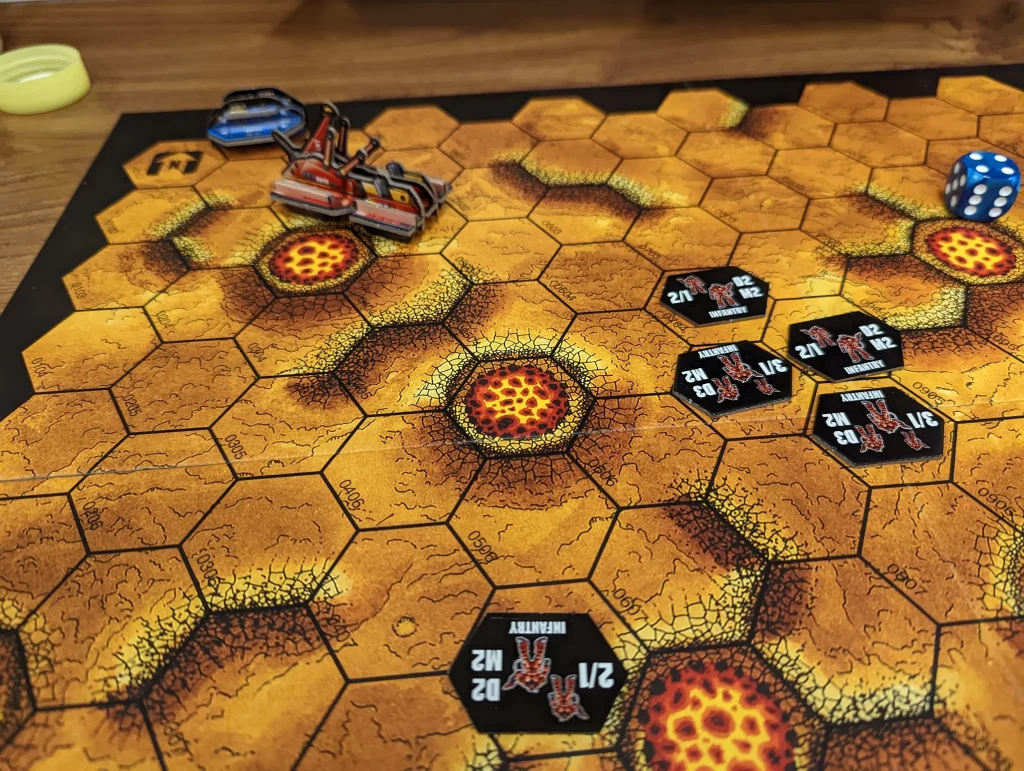OGRE

About a decade ago, I backed the Kickstarter project for Steve Jackson Game’s OGRE. It was a small pocket game from the 1970s, but what it has turned into is something considerably larger. It turned up, we played it once, and since then it has sat on top of a wardrobe gathering dust.
Until last night.
In 2085, armored warfare is faster and deadlier than ever. Hovercraft, tanks, and infantry slug it out with tactical nukes. But the most feared weapon of all needs no human guidance. It’s a giant cybernetic tank bristling with guns and missiles.
http://www.sjgames.com/ogre/
The OGREs in question are huge cybernetic tanks, fighting against the armies of human survivors n a post-apocalyptic world. The rules are quite simple, and the games we had (we fitted three games into the evening at FWGS) were quite quick.
We started with the asymmetric first scenario – an OGRE Mk III against a small army of tanks, GEVs (ground effect vehicles – hovercraft) and infantry. The idea of the scenario is that the OGRE has to make it through the defending army, destroy the human command centre, and then make it back safely to where it started from.
In our first game, I had the OGRE, and tried a careful approach to ensure I was only taking on a minimum number of enemy units at a time. The OGRE trundles along with a move of 3 hexes/turn, and has quite a short range for its weapons. Apart from the range 5 missiles (of which it only has two), its guns are limited to range 3 (primary) and 2 (secondary). With only one unit to play with, and pretty much having to get right up to the enemy to shoot them, tactics couldn’t be that complicated.
I used the missiles to take out a couple of units, then lost my main gun, so I thought I wasn’t going to make it.
The attack role consists of adding up the attack strength of everything firing, and comparing it with the defence rating. Then depending on the ratio (1:1, 2:1, 3:1 etc), you need to roll a number or higher on a D6 to do damage. OGRE units can take multiple hits, other units are either destroyed or damaged by a successful hit. In our first game, we got things wrong, and rounded up in favour of the attacker. I’m not sure whether that benefited one side or the other.
Despite losing my biggest weapons, the OGRE ended up making short work of the puny human units ahead of it. Each turn, the OGRE took a bit of damage, and a couple of human units were destroyed. Before long all they had left were some infantry who really didn’t want to fight an OGRE by themselves.
So the command post was destroyed, and the OGRE trundled its way back home. It was a resounding victory for the OGRE. The whole game, after setup, took about an hour.
We decided to have a second game, with me taking the human forces this time. I decided to try and mass my units to attack the OGRE all at once.
The second game went much the same as the first game. I tried to take out the OGRE’s weapons as quickly as possible, but lost my units too quickly. Once again, the OGRE trundled across the nuclear scarred battlefield and destroyed the human command post.
The scenario was meant to be very asymmetric – one powerful unit against lots of smaller units. Whether it’s meant to be ‘balanced’ though I don’t know, since neither battle was in any way close.
It also felt that the tactical options were limited in both games. For a modern/futuristic war game, weapon ranges are really short so you pretty much have to get in close to do anything.
That game also took about an hour, so we had time for a third game. This time we did OGRE v OGRE, with a couple of Mk IIIs going head to head.
The game was, unsurprisingly, a lot more balanced. Initially, we tried taking out each other’s primary weapons, but then red rammed blue, causing a lot of damage to the OGRE’s treads. One of the possible tactics is taking out the OGRE’s ability to move, and as more treads are taken out, its ability to move is reduced.
For a while we both continued to ram each other, until it got to the point where my (blue) OGRE was down to a movement of one, and close to being unable to move at all. So I started backing off, and succeeded in taking out the last of red’s weapons. So red turned and ran, with blue following trying to shoot out their treads.
With one tread remaining, red got to the edge of the board, but then I got another successful shot and blue was stuck. Without weapons to shoot back with, they were quickly destroyed.
Overall, OGRE is a relatively quick and simple game. The deluxe sixth edition is probably a bit over engineered given this. The models are really nice and high quality, but the rules felt they matched the original smaller game better. If it wasn’t such a big and bulky game, it would be a good game to have available for finishing off an evening with. But as it is, it pretty much has to be the main game of the evening. But at least we get to play multiple scenarios.
It wasn’t bad, and we had fun playing it. It just seemed simple given its size. We should probably try the more complicated scenarios and see how much they add to the game. Multiple OGREs and larger sets of human units would probably add to the tactical complexity, and might provide a fairer view of how well the game works.





